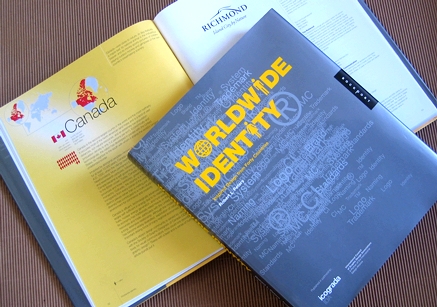
Rockport, Massachusetts
As stated in Rockport Publishers’ news release, ”Worldwide Identity offers inspiration from 40 countries and showcases more than 300 identities from around the globe from branding the City of Sydney in Australia, to private-label Hong Kong tea, to Brazilian supermarkets, to Levi’s in Singapore, to Danish crown corporation heraldry, and wine in South Africa. Worldwide Identity, compiled in collaboration with Icograda, explains the process of identity design by defining both the ‘Brief’ and the ‘Solution.’ This clear and concise manner assists us in seeing how innovative, distinctive, and appropriate identities arise from designers thorough understanding of mandate and cultural context.”
The book’s author Robert L. Peters states: ”Designers have given shape to the identities of corporations, organizations, locations, events, products, and services that surround us. Information, ideas, and communication are the new currency in today’s virtual world and in this age of ideas, graphic designers play an increasingly vital role in creating economic success, shaping communities, and forming culture. Identity lies at the very core of society, and is the key to our understanding of self. Understanding culture is imperative in avoiding identity crisis and rootlessness, and is a prerequisite for the effective shaping of identities and communication. Everywhere in our shrinking world, we can witness increased homogenization, erosion of indigenous culture, the emergence of serial monotony, and the loss of both individual and collective identity. However, at the same time, the Internet has allowed the world to literally be ”brought to the doorstep” of designers, along with the opportunities this presents.”
Worldwide Identity showcases identity projects from around the world, compiled in association with the International Council of Graphic Design Associations (Icograda). The book includes a contextual essay about each of the 40 countries from which works are drawn, along with information including maps, flags, and comparative metrics such as national population, area, languages, and GDP per capita. It also includes directories of Icograda member associations around the globe, and all contributors.
Robert L. Peters is the founding principal of Circle, an international visual communications consultancy based in Winnipeg, Canada. He was president of Icograda from 2001-2003, and is active internationally as a consultant and design strategist, writer, policy advisor, juror, and guest lecturer.
Published by Rockport in partnership with Icograda, Worldwide Identity is available in bookshops worldwide, and can be purchased online. Contact Liz Polay-Wettengel at Rockport Publishers for excerpt material, images, author interviews, or any other information: Tel. +1 978 282 3511, liz@rockpub.com, www.QuaysidePublishingGroup.com
+++++++++++++++++++++++++++
Worldwide Identity:
Inspired Design from Forty Countries
Author: Robert L. Peters
ISBN: 1-59253-187-3, Rockport Publishers, Inc.
Hardcover, 256 pages, 400 color images.
Size: 228 x 280 mm (9 x 11 inches)
$45.00 US / 29.99 / $63.00 CAN
Read book reviews at Amazon. Read the ‘Identity Matters’ editorial (as a PDF, 792 K) from the Opinion/Commentary article originally published in the July 2005 issue of Communication Arts magazine [CA #337, Illustration Annual 46]).











